The top image stacking software for photomicrography includes Zerene Stacker ($189) for superior image quality and extensive retouching tools, Helicon Focus ($115) for user-friendly operation and faster processing, and Adobe Photoshop for seamless workflow integration. Free alternatives like Combine ZP and Focus-Stack offer basic functionality for beginners. Your choice should balance output quality, editing capabilities, and budget constraints. Dive deeper to discover which features will truly elevate your microscopic imaging projects.
Best Image Stacking Software Tools for Photomicrography
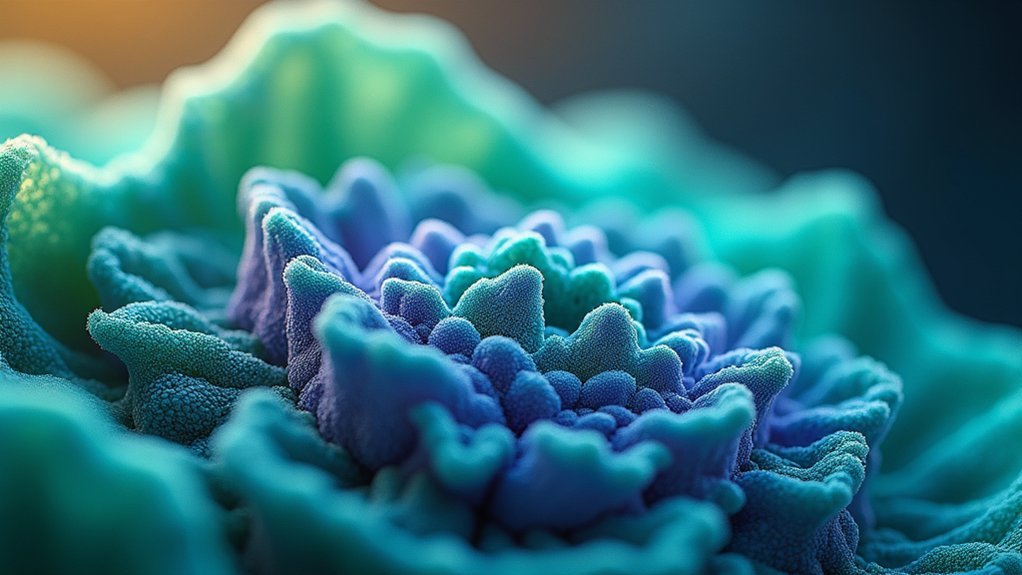
Four leading software options dominate the image stacking landscape for photomicrography enthusiasts.
Zerene Stacker stands as the industry standard, offering superior image quality and extensive retouching tools in its $189 Prosumer edition—ideal if you’re serious about macro photography.
Helicon Focus provides a user-friendly alternative with faster processing and a $115 lifetime license, though it has limitations in resolution and editing flexibility.
If you’re already a Photoshop user (CS4 or newer), you’ll find built-in focus stacking capabilities that integrate seamlessly with your existing workflow.
For beginners or those on a budget, Combine ZP offers a free option, but be prepared for a less intuitive interface and outdated features.
When paired with specialized equipment like the Canon MP-E 65mm lens, these stacking software tools transform your photomicrography results.
Understanding Image Stacking Fundamentals for Microscopy
Image stacking in microscopy works by combining multiple images taken at different focus planes, using specialized algorithms to create a fully-focused composite image.
You’ll encounter three main processing methods: weighted average, which blends pixels based on contrast values; pyramid stacking, which analyzes multiple resolution levels simultaneously; and depth mapping, which creates a 3D model of your specimen’s topology.
These computational approaches effectively overcome the limited depth of field in high-magnification microscopy, allowing you to capture intricate details throughout your specimen’s entire structure.
Focus Plane Compilation Methods
At the heart of successful photomicrography lies the mastery of focus plane compilation methods. When you’re capturing three-dimensional microscopic subjects, you’ll need to carefully sequence your image acquisition, ensuring proper overlap between focus steps to prevent banding artifacts in your final stacked image.
Your choice of stacking program greatly impacts results. Helicon Focus prioritizes speed and user-friendliness, making it ideal for beginners or high-volume work. Meanwhile, Zerene Stacker delivers industry-standard quality that serious microphotographers often prefer.
Both programs analyze your focus planes differently—some use pixel-based algorithms while others employ depth mapping techniques.
For best results, you’ll need to maintain pristine sensor cleanliness and proper technique throughout the capture process. Even the best compilation methods can’t fully compensate for dust spots or inadequate focus step intervals in your source images.
Depth-of-Field Extension Principles
When viewing microscopic subjects, you’re inevitably confronted with an optical challenge: the extremely shallow depth of field that high-magnification lenses produce. This limitation means only a thin slice of your three-dimensional specimen appears in focus at any time.
Image stacking addresses this constraint by combining multiple images captured at different focal planes. You’ll need to guarantee appropriate overlap between focus steps to avoid banding artifacts in your final composite. Tools like focus sliders help achieve the precise incremental adjustments required for high quality results.
The process transforms what would be a partially blurred view into a completely sharp representation of your subject.
Specialized software such as Helicon Focus and Zerene Stacker employ sophisticated algorithms to analyze and merge only the sharpest portions of each image, effectively extending your depth of field beyond what’s physically possible in a single shot.
Z-Stack Processing Algorithms
The foundation of successful image stacking rests on the algorithms that power the process. When you’re creating photomicrographs, these computational methods combine multiple focal plane images into one composite with enhanced depth of field.
For ideal results, you’ll need to capture images with proper overlap between focus steps. This prevents banding artifacts while maintaining sharpness throughout your subject’s depth.
Your equipment matters considerably—Canon MP-E 65mm or Nikon CF objectives provide the detail necessary for effective stacking.
Software options like Helicon Focus offer efficient processing, though Zerene Stacker remains the industry standard despite slower speeds. Each program uses distinct algorithms to merge your stacked images into a cohesive final product.
After stacking, you’ll likely need to retouch in Photoshop or similar software to address artifacts and refine your composite image.
Key Features to Evaluate in Photomicrography Stacking Software
When selecting photomicrography stacking software, you’ll need to assess quality control parameters like final image resolution, noise levels, and color saturation accuracy.
Your workflow efficiency depends on an intuitive interface that supports both batch processing and maintains original image quality without program crashes.
Advanced retouching tools can make or break your results, with non-destructive editing options giving you greater flexibility to perfect the final stacked image.
Quality Control Parameters
Selecting the right image stacking software for photomicrography requires careful evaluation of several critical quality control parameters. During each stacking run, you’ll need tools that provide consistent, reliable results while giving you sufficient control over the final output.
- Output quality – Prioritize software that maintains high resolution and color fidelity. Zerene Stacker typically produces superior results compared to Helicon Focus, which may sacrifice detail and saturation.
- Retouching capabilities – Look for non-destructive editing options that preserve your ability to make adjustments. Zerene’s approach allows for flexible quality control throughout your workflow.
- Parameter adjustment – Verify you can fine-tune focus depth and contrast thresholds. The best software lets you optimize these settings for your specific specimen, giving you precise control over the stacking process.
Interface and Workflow
Three critical interface elements can make or break your photomicrography workflow efficiency.
First, prioritize software with an intuitive interface design, as this dramatically reduces the learning curve and allows you to focus on your specimens rather than maneuvering through complex menus.
Second, evaluate batch processing capabilities. Software that can handle multiple image stacks simultaneously will save you countless hours during large-scale projects. This feature becomes invaluable when working with extensive sample collections.
Finally, consider how the software integrates with your existing tools. Seamless compatibility with applications like Adobe Photoshop enables a streamlined workflow from capture to final polish.
Look for non-destructive editing options that maintain image integrity while providing flexibility for adjustments. The ideal interface balances powerful features with accessibility, supporting efficient workflow from acquisition through final output.
Advanced Retouching Capabilities
The quality of your photomicrography output hinges greatly on the advanced retouching capabilities your stacking software provides.
When comparing options, consider how retouching tools affect your final image workflow and flexibility.
- Non-destructive vs. Destructive – Zerene Stacker offers non-destructive retouching, preserving editing flexibility, while Helicon Focus uses destructive edits that limit post-processing options.
- Sub-stack Creation – Advanced software allows you to create and retouch sub-stacks, essential for precise adjustments in complex photomicrography subjects.
- Algorithm Combination – Zerene’s robust retouching facilities let you blend outputs from different algorithms, effectively addressing artifacts that a single method might miss.
For professional results, complement your stacking software with Photoshop for final cleanup, as even the best stacking algorithms benefit from additional refinement.
Zerene Stacker: Professional Capabilities and Workflow Analysis
Widely recognized as the industry standard in photomicrography focus stacking, Zerene Stacker delivers exceptional image quality with remarkable detail preservation and minimal artifacts. When you need pristine stacked images with complete control over the process, this software stands above competitors despite its slower processing speed.
| Feature | Benefit | Best For |
|---|---|---|
| Non-destructive retouching | Preserve original data | Precision work |
| Sub-stack creation | Layer management | Complex projects |
| Parameter control | Customization | Experienced users |
| Pricing options | Accessibility | Various budgets |
| Reliable support | Workflow confidence | Deadline-driven work |
You’ll appreciate the tiered pricing structure ($39-$289), making professional-grade focus stacking accessible whether you’re a student or established photographer. The exceptional customer support guarantees you’re never left struggling with technical issues during critical projects.
Helicon Focus: Performance Benefits and Limitations
Many photographers gravitate toward Helicon Focus for its impressive speed and vibrant outputs, offering noticeably higher saturation and reduced noise compared to alternatives.
Helicon Focus delivers swift processing with rich, clean outputs that outshine competitors in both vibrancy and noise reduction.
The software’s flexibility in licensing—$55 yearly or $200 for permanent use—makes it accessible for various budgets.
Performance benefits and limitations to evaluate:
- Speed advantage – Helicon Focus processes stacks rapidly, ideal for high-volume photomicrography projects.
- Stability concerns – Internet dependency can trigger crashes during critical sessions.
- Limited editing control – Destructive retouching tools and lack of sub-stack capabilities often necessitate Photoshop for final adjustments.
You’ll appreciate Helicon Focus’s quick results, but may find yourself constrained by its inability to control contrast thresholds fully during B-stacks, especially if you’re performing detailed photomicrography work.
Free Alternatives: Combine ZP and Focus-Stack Applications
For photographers operating on limited budgets, free alternatives like Combine ZP and Focus-Stack offer compelling options without the financial commitment of premium software.
Combine ZP, last updated in 2010 for Windows XP/Vista, delivers basic functionality but features a less intuitive interface that requires user adjustment for ideal results.
Focus-Stack presents a modern alternative through its command-line application. While you’ll need to learn basic terminal commands, it provides significant advantages including batch processing capabilities and full-resolution outputs in PNG format.
Despite longer processing times, Focus-Stack produces image quality comparable to commercial options.
Both tools require organized workflow and some technical familiarity, but they’re valuable resources if you’re willing to trade convenience for cost savings in your photomicrography projects.
Adobe Photoshop’s Built-in Stacking Functionality
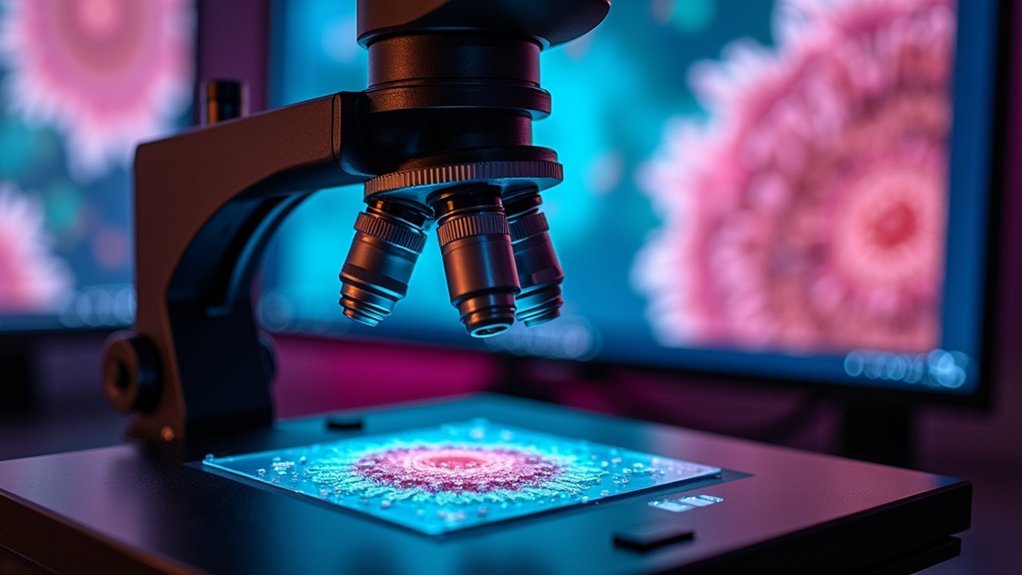
Adobe Photoshop’s built-in stacking capabilities offer you powerful tools for photomicrography through its Auto-Align features that automatically correct minor positioning variations between your image layers.
You’ll find focus stacking scripts that seamlessly blend multiple photos taken at different focal planes, creating impressive depth-of-field in your microscopy work.
Photoshop’s batch processing options also allow you to apply these stacking techniques to multiple sets of images simultaneously, streamlining your workflow when handling numerous photomicrography sequences.
Auto Align Features
Since its introduction in CS4, Photoshop’s built-in stacking functionality has become a powerful option for photomicrographers seeking to create composite images with enhanced depth of field.
The Auto-Align Layers feature automatically detects and corrects alignment discrepancies between your images, ensuring seamless stacking even with slight focus variations.
You’ll appreciate Photoshop’s thorough approach to stacking:
- Auto-align features correct misalignments automatically, saving you hours of manual adjustments
- Multiple blending modes like Mean or Median minimize noise and artifacts in your final output
- Integrated retouching tools allow you to refine and enhance your stacked image after initial processing
Photoshop supports high-quality file formats including RAW and TIFF, helping you maintain image integrity throughout your photomicrography workflow.
Focus Stacking Scripts
While auto-alignment handles the initial layer positioning, Photoshop’s focus stacking scripts take the process several steps further. Since CS4, these built-in tools have streamlined what was once a manual, time-consuming process.
You’ll find these focus stacking scripts under “Auto-Blend Layers,” where selecting “Stack Images” and “Seamless Tones and Colors” optimizes your composite. These options intelligently merge your differently-focused images while minimizing artifacts and ensuring smooth shifts between areas.
For good results, you’ll want to master both the automated scripts and manual refinement techniques. After the automated stacking completes, you can enhance your photomicrography with adjustment layers and retouching tools.
While there’s a learning curve to Photoshop’s interface, the focus stacking scripts deliver professional-quality depth of field that’s particularly valuable for microscopic subjects.
Batch Processing Options
For researchers who frequently capture dozens of microscopic image sequences, Photoshop’s batch processing capabilities offer significant time savings.
You’ll find Adobe’s “Load Files into Stack” feature particularly valuable when working with multiple photomicrographs that need consistent processing treatment.
- Select multiple files simultaneously and apply stacking algorithms to all images at once, streamlining your workflow for large datasets.
- Access the built-in alignment and blending functions to create composites with enhanced depth of field.
- Refine the final stacked image using Photoshop’s familiar retouching tools to address any artifacts.
These batch processing options allow you to maintain an efficient workflow while ensuring high-quality results.
Since you’re likely already familiar with Photoshop’s interface, you’ll find this approach integrates seamlessly with your existing photomicrography practices.
Processing Speed Comparison Across Major Stacking Tools

When choosing image stacking software for photomicrography, processing speed often becomes a decisive factor in your workflow efficiency.
Helicon Focus demonstrates impressive performance, processing images in under 9 seconds during demo mode, though you might experience lower output resolution in the Lite version.
Rapid processing in seconds with Helicon Focus, though Lite users may notice resolution trade-offs.
While Zerene Stacker is considered the industry standard for quality, it’s particularly slower in initial stacking compared to Helicon Focus.
The open-source Focus-stack alternative averages about 50 seconds for multiple images, delivering quality comparable to Helicon despite the longer processing time.
At $30 per year, Helicon Focus offers speed advantages over free alternatives.
However, it’s worth mentioning that not all users experience resolution loss with Helicon, suggesting demo limitations might affect your perception of processing speed and better stacked image quality.
Retouching Capabilities and Artifact Management
Beyond processing speed, the quality of your final photomicrography stacks heavily depends on how well you can address inevitable artifacts.
Zerene Stacker offers superior retouching capabilities compared to Helicon Focus, allowing you to create sub-stacks and precisely manage stacking artifacts that become more pronounced at higher magnifications.
- Helicon Focus uses destructive editing, limiting your flexibility for final adjustments, while non-destructive workflows in Photoshop provide greater control.
- Combining outputs from different stacking algorithms can considerably reduce artifacts in your final images.
- Pre-stack preparation, including thorough sensor cleaning, dramatically reduces dust trails and halos.
For best results, you’ll want to complete your workflow in Photoshop after stacking, as its advanced tools help address residual artifacts that stacking software might miss.
Output Quality and Resolution Considerations

Although both leading software options can produce impressive results, the final output quality of your photomicrography stacks differs greatly between platforms.
Zerene Stacker delivers superior detail retention and is considered the industry standard, despite its slower initial processing time compared to Helicon Focus.
You’ll notice that Helicon’s demo and Lite versions may produce lower resolution outputs than the full license version, while still offering rapid stacking capabilities.
At high magnification, issues like dust trails and stacking halos become more prominent, requiring meticulous sensor cleaning and ideal stacking techniques.
For maximum quality, avoid Helicon’s destructive retouching tools and instead export your stacked images to Photoshop for final adjustments.
Your choice of software considerably impacts the clinical precision of your photomicrography work.
Hardware Requirements for Efficient Stacking Operations
The backbone of successful photomicrography stacking lies in your hardware setup. Your equipment directly impacts the quality and efficiency of your stacking workflow.
Before selecting any software solution, verify your system meets these essential hardware requirements:
- Specialized optics – Invest in high magnification lenses like the Canon MP-E 65mm or quality microscope objectives to capture the fine details needed for effective stacking.
- Precision movement controls – Use motorized stacking rails or focus sliders to achieve consistent, precise adjustments between focal planes.
- Robust computing power – Run your stacking software on a system with at least 16GB RAM and a fast processor to handle high-resolution images efficiently.
Proper lighting is equally vital—ring lights or LED illuminators provide uniform illumination while minimizing shadows that can compromise your stacked results.
Specialized Tools for Scientific Research Applications
Now that you’ve established your hardware foundation, let’s examine the specialized software tools that power scientific photomicrography research. Your choice between different software options will greatly impact your results.
Helicon Focus delivers rapid stacking with an intuitive interface, making it ideal for time-sensitive research projects, though its retouching capabilities are limited.
Conversely, Zerene Stacker—the industry standard—offers superior quality output with extensive retouching tools and precise parameter control, albeit at slower processing speeds.
For scientific applications requiring extreme detail, pair your stacking software with high-quality enlarger lenses or Nikon CF objectives.
Consider implementing Stackshot automation to streamline your image capture workflow, especially for large specimen sets requiring consistent focal plane increments.
This combination of specialized tools will elevate your photomicrography from simple documentation to publication-quality visualization.
Cost-Benefit Analysis of Commercial vs. Open-Source Options
When evaluating image stacking software for photomicrography, you’ll need to carefully weigh the financial investment against performance benefits.
Commercial options like Helicon Focus ($200 lifetime/$55 yearly) and Zerene Stacker ($39-$189) offer intuitive interfaces and robust support, while free open-source alternatives retain original resolution but require command-line knowledge.
Your cost-benefit analysis should consider:
- Budget constraints – Open-source options like Focus-stack cost nothing but demand more technical expertise.
- Processing requirements – Zerene delivers superior quality but processes slower than Helicon.
- Long-term value – One-time purchases like Affinity Photo may prove more economical than subscriptions.
For beginners with budget concerns, open-source tools are a good choice.
If quality and support are priorities, commercial options justify their cost through regular updates and user-friendly features.
Frequently Asked Questions
What Is the Best Software for Stacking Photos?
For stacking photos, Zerene Stacker is your best choice for quality, while Helicon Focus offers user-friendly speed. If you’re budget-conscious, try free alternatives like Combine ZP or the command-line tool Focus-stack.
How Do You Stack Photos in Photography?
To stack photos in photography, you’ll need to capture multiple images at different focal planes, then use software like Helicon Focus or Zerene Stacker to combine them into one sharp composite with enhanced depth of field.
How to Do Image Stacking in Astrophotography?
In astrophotography, you’ll capture multiple exposures of your celestial target, then use specialized software like PixInsight or APP to align and combine them, reducing noise and enhancing details in your final image.
What Is Deepskystacker?
DeepSkyStacker is a free astrophotography software you’ll use to combine multiple images of celestial objects. It aligns and stacks your exposures, reducing noise and enhancing details that would be invisible in single shots.
In Summary
You’ll find the perfect image stacking software by evaluating your specific photomicrography needs. Whether you choose Zerene Stacker for professional results, Helicon Focus for a streamlined workflow, or an open-source alternative, prioritize output quality and your hardware capabilities. Don’t hesitate to test several options before investing – the right tool will dramatically improve your microscopy images’ depth of field and clarity.
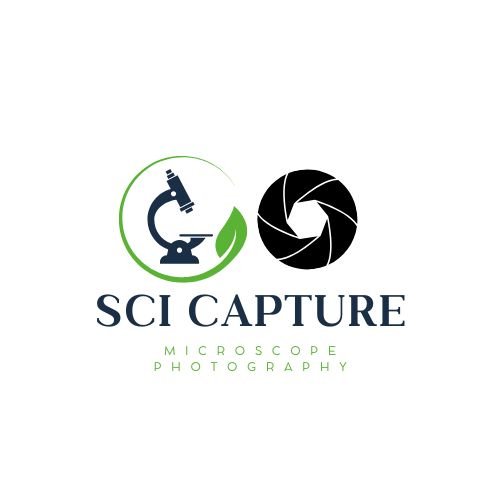

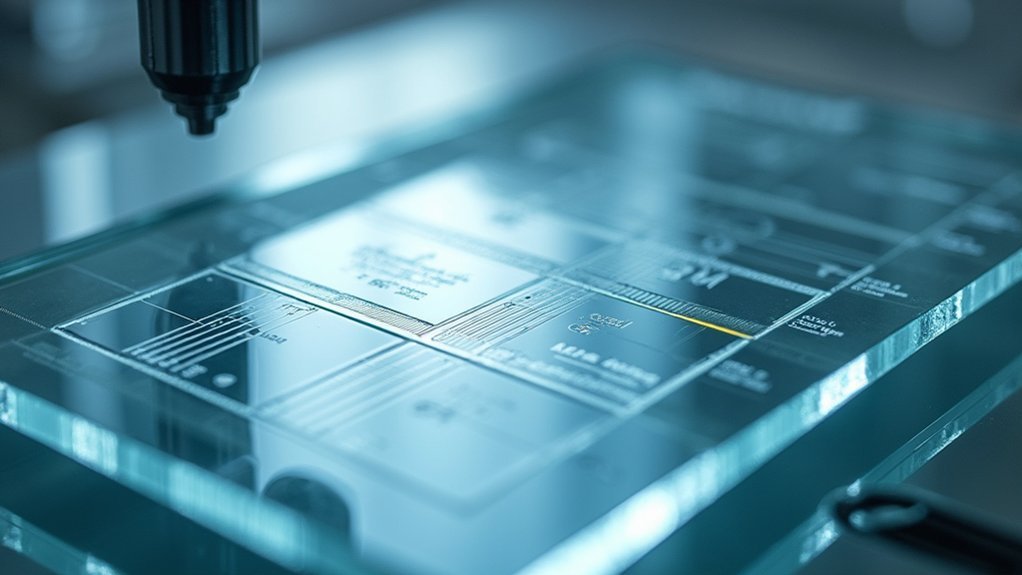
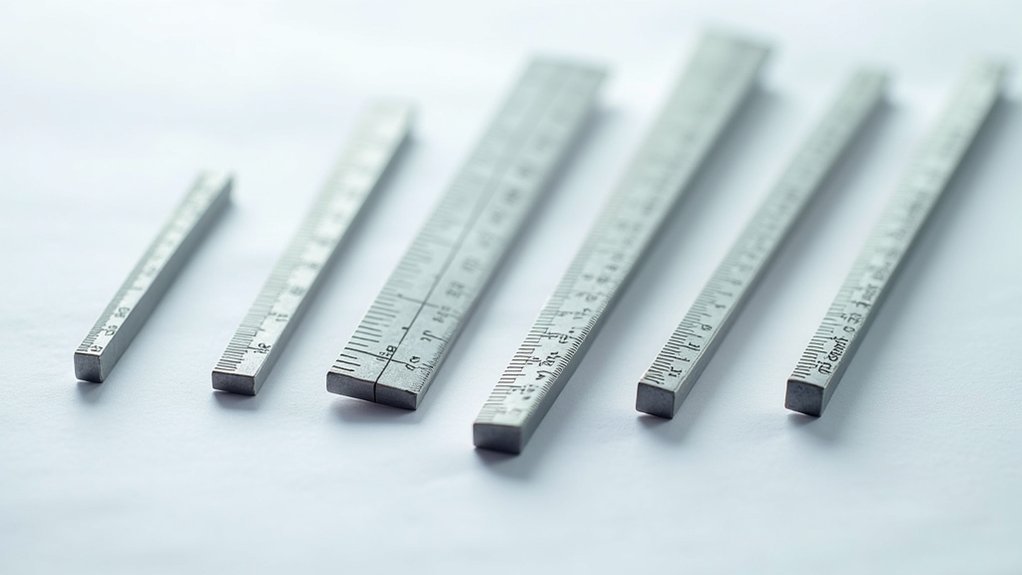

Leave a Reply